15 Best Woods for Staining (And Worst!)
Staining wood is a great way to give it fresh life, protection, and color. While most types of wood are very adaptable and receptive to stain, certain woods are better for staining than others.
However, although some wood is better for staining than others, any wood can get stained as long as you use the right type of stain and apply it properly.
In this article, I’ll uncover the best wood for staining, the worst woods for staining, what to do if you want to use wood that isn’t receptive to stain, and steps you can take to give it the color you need. Let’s dig in!
- The best woods for staining include white oak, red oak, ash, cedar, walnut, and more.
- It’s best to look for options where the wood grain is consistent and has few imperfections.
Best Types of Wood For Staining
The key to choosing a wood that’s good for staining is to look for wood with a consistent grain pattern and as few imperfections as possible. Imperfections in the wood and complex grain patterns make it more difficult for stains to adhere to the wood. Here are some of the best woods for staining!
1. White Oak
Oak woods are considered by many to be the overall best wood for staining. Among the different types of oak, white oak is one of the most popular. White oak is commonly used to make cabinets, hardwood floors, and other woodworking and carpentry items.
While white oak has large, open pores that readily absorb stain, they’re so large and open that you may need several coats of stain for it to adequately absorb and change to your desired color.
2. Red Oak
In addition to white oak, red oak is the most popular type of oak wood when it comes to sustainability. As with white oak, red oak is used in a wide range of carpentry and woodworking implementations, including cabinets, furniture, and flooring.
The main difference between white and red oak is that red oak is better at absorbing stains than white oak, which means it will absorb stains faster and deeper. However, whether you prefer the color tone of red or white oak, either option is great for staining.
3. Chestnut
Although chestnut looks like a complicated wood on the outside due to its color and grain pattern, it is actually one of the more simplistic options. It’s because of this simplicity that chestnut is also one of the best woods for staining. It’s one of the more porous woods out there and has lovely warm tones, making it a favorite for kitchens and household furniture.
4. Hickory
If you’re looking for wood that’s as durable as it is beautiful, hickory wood is the way to go. Hickory is one of the hardest and most durable woods used in carpentry and woodworking, and it’s loved for its unique brownish color and hue.
As with oak and many others, hickory has large and open pores making it very receptive to wood stains and finishes.
5. Ash
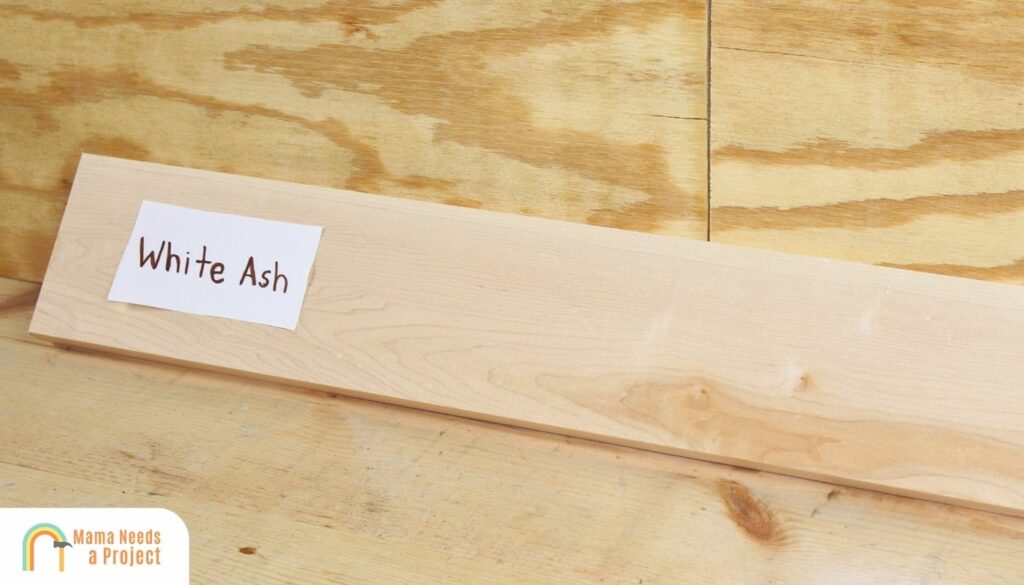
Ash is another great wood for staining because of how open-grained and porous it is. Additionally, ash wood is one of the most naturally beautiful woods, making it a popular option for staining. Add the fact that ash wood has very large pores, and you should have no trouble staining it to your desire.
6. Cedar Wood
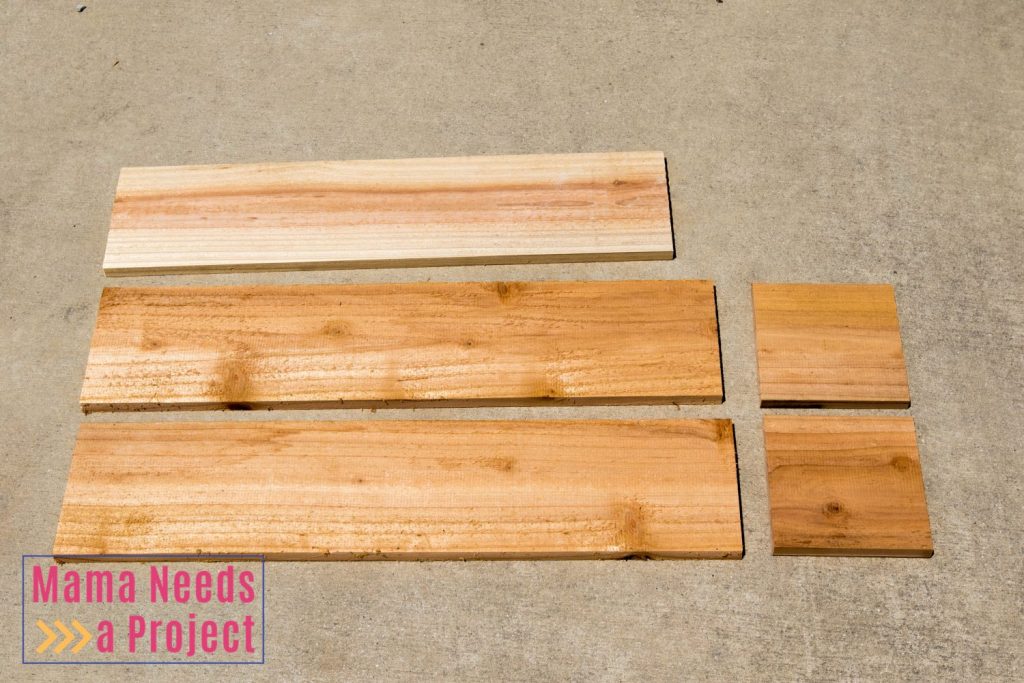
In terms of natural beauty and grain pattern, cedar is one of the best woods for interior decorating and furniture on the market. It’s especially popular because of its vintage farmhouse look and style.
Cedar is tight-grained but has large, open pores that are receptive and absorbant of wood stains. As such, it’s a fairly easy wood to stain and goes well in homes craving a farmhouse look.
Check out these amazing wood stains for cedar I highly recommend!
7. Walnut
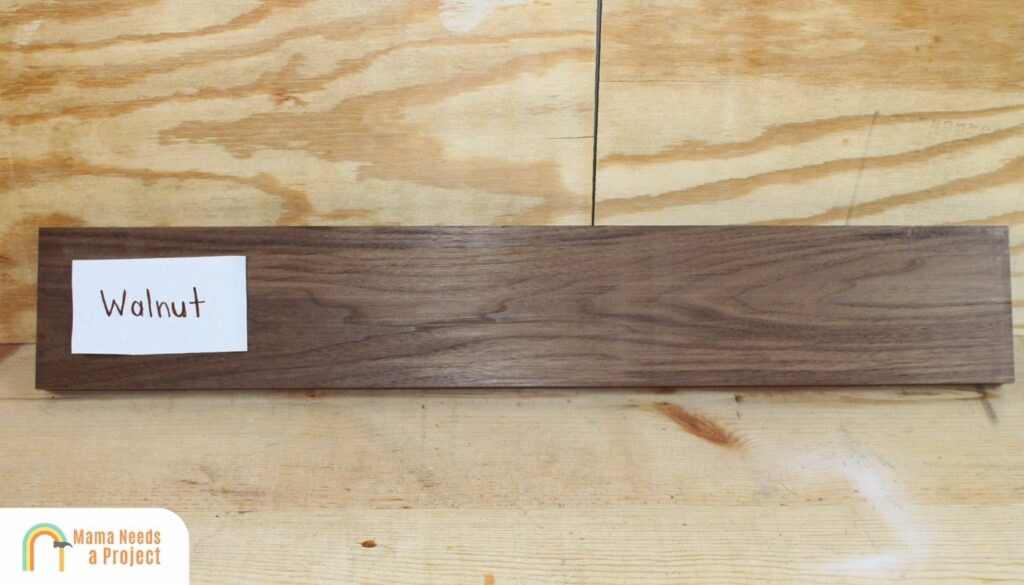
Walnut is another decent choice if you want a wood that accepts stains well and evenly. Walnut typically doesn’t require any pre-staining or conditioning, and it’s easy to give it a nice, even coat.
8. Cherry
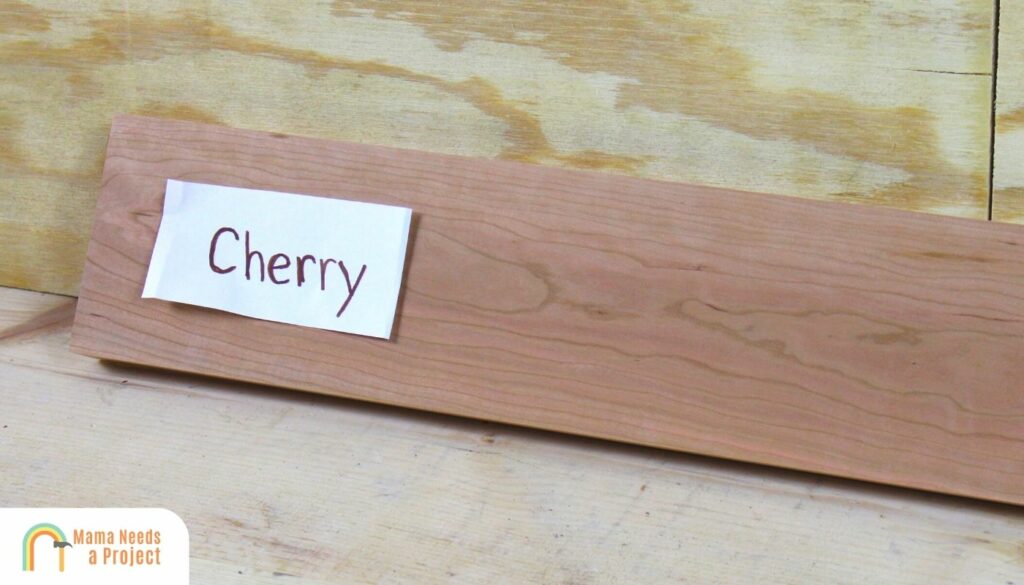
Cherry wood is a complicated wood when it comes to how well it stains.
On the plus side, cherry is a very hard wood, which means it won’t look spongy or blotchy if you stain it. It also has a very fine grain pattern making it a good candidate from that perspective.
However, because of cherry wood’s beautiful natural color and tone, most experienced woodworkers shudder at the idea of staining cherry wood. It’s known as one of the most beautiful woods on the market, which means that if you apply a stain, it’s best to use one that won’t take away from its natural color.
Additionally, while cherry wood has a fine grain pattern, it has relatively small pores, which doesn’t make it quite as absorbent as other hardwoods. Therefore, because of these pros and cons, cherry is somewhere in the middle as to whether it’s a good wood to stain or a bad one.
9. Mahogany
As with cherry wood, mahogany is another complicated wood when it comes to staining.
Mahogany doesn’t have any issues with accepting stains, thanks to its large and open pores, and will typically provide a high-gloss, luxurious finish.
However, because of mahogany woods natural grain pattern and beauty, most people cringe at the notion of staining it. It’s naturally beautiful enough that mahogany typically doesn’t require a stain, even though it will accept stains well.
Worst Woods for Staining
1. Maple
Maple is another wood that falls into the category of woods that aren’t especially good to stain. Although maple is considered a hardwood, which is positive, it has extremely tight pores and a dense grain pattern.
Therefore, maple does not receive or absorb stains well and actively tries to repel it. Maple also has an uneven grain pattern, which means that coats will appear uneven and scattered rather than smooth. If your heart is set on staining maple wood, however, you can optionally apply a pre-conditioner, as this might solve some of your problems. More on that later!
2. Yellow Pine
Unlike many of the other woods on this list, yellow pine is not one of the best woods for staining. Yellow pine is very soft, which means that it could appear blotchy or spongy when you stain it. As such, it’s best to use a shellac or similar type of stain if you want to add a finish to yellow pine.
3. Pine Boards
As with yellow pine, pine boards of any kind aren’t especially good at receiving stains. As I said before, pine is a soft wood rather than a hardwood, which means it doesn’t absorb stain well and could appear blotchy and distorted if you try to stain it.
4. Poplar Wood
In spite of its name, poplar wood is not one of the most “poplar” woods in terms of its sustainability. Poplar is a very soft wood which means that stain doesn’t always look even or complete when you apply it. In most cases, this results in wood that appears scattered, dull, lifeless, and otherwise unappealing.
5. Dark Walnut
Unlike other types of walnut wood, dark walnut isn’t a great wood for staining. You’ll need to apply quite a few coats of stain to get an even coat on walnut wood, and even then, there’s no guarantee that it will be smooth and seamless. Additionally, you’ll need to sand and varnish walnut before you can stain it, which takes away from its natural color and beauty.
6. Birch Wood
As with most other soft hardwoods, birch wood isn’t an ideal candidate for staining. It can appear uneven and blotchy when you try to stain it, especially with dark colors. Therefore, if you are staining birch plywood or hardwood, it’s essential to prep the wood for stain to ensure an even finish. It’s recommended to use a pre-stain wood conditioner (more below!), which will help the wood absorb the stain more uniformly.
How to Choose the Best Wood For Staining
As you can see, there are many different types of wood and many different variations as to how well they accept stain. While I’ve laid out the best and worst, here is some additional information as to how to choose a wood for staining if it wasn’t on our list.
How Porous It Is
Porosity is one of the main factors to consider when deciding what type of wood is best for staining. Porosity refers to how well air and moisture can enter into and travel through wood. The more porous the wood, the easier it is for stains to enter and soak through it, providing a clean even coat.
The larger and wider the pores are, the higher its level of absorption. However, while large pores make it easier for stain to penetrate the wood, it also means that it will absorb the stain more readily. As a result, you may require additional coats to saturate porous wood adequately.
The Grain Pattern
Next up, you have to consider a wood grain pattern when deciding if it’s a good option for staining. Grain pattern doesn’t necessarily affect how well a wood accepts stain, but it does affect how good the stain will look after it has been applied.
In general, wood that has an open and even grain pattern is the best wood for staining because it will have a lighter color. Knotty or tight-grained wood will have a darker overall appearance when you stain it because of how the wood absorbs the stain.
Texture of the Wood
Texture is extremely important when it comes to choosing the right wood for staining. In general, you need wood to be smooth and sleek if you want it to stain evenly. If it’s too textured, the stain won’t apply evenly and will appear blotchy.
If you want wood to have a textured finish, the best option is to use a stain that’s advertised as a textured finish. That way, even though the wood is perfectly smooth and stainable, it will accept the stain well and have the desired end texture.
Type of Wood: Hard or Soft
Finally, it’s essential to take the hardness and softness of the wood into consideration. However, there’s a fine line to walk in this regard. If wood is too hard, it will be overly dense, and the fine wood grains and pores won’t allow stains to enter the wood.
On the other hand, if wood is too soft, it won’t absorb stains evenly and have a final look that’s blotchy, uneven, and downright ugly. Therefore, hardwoods that are on the softer side and not quite as dense, such as ash, oak, cedar, chestnut, and hickory, are the best woods for staining.
Different Types of Wood Stain
Once you have determined which wood you want to use for your upcoming staining project, you then need to decide what type of wood stain to use. There are six basic types of wood stains, and each one has unique qualities and is perfect for certain woods and situations.
Water Based Stain
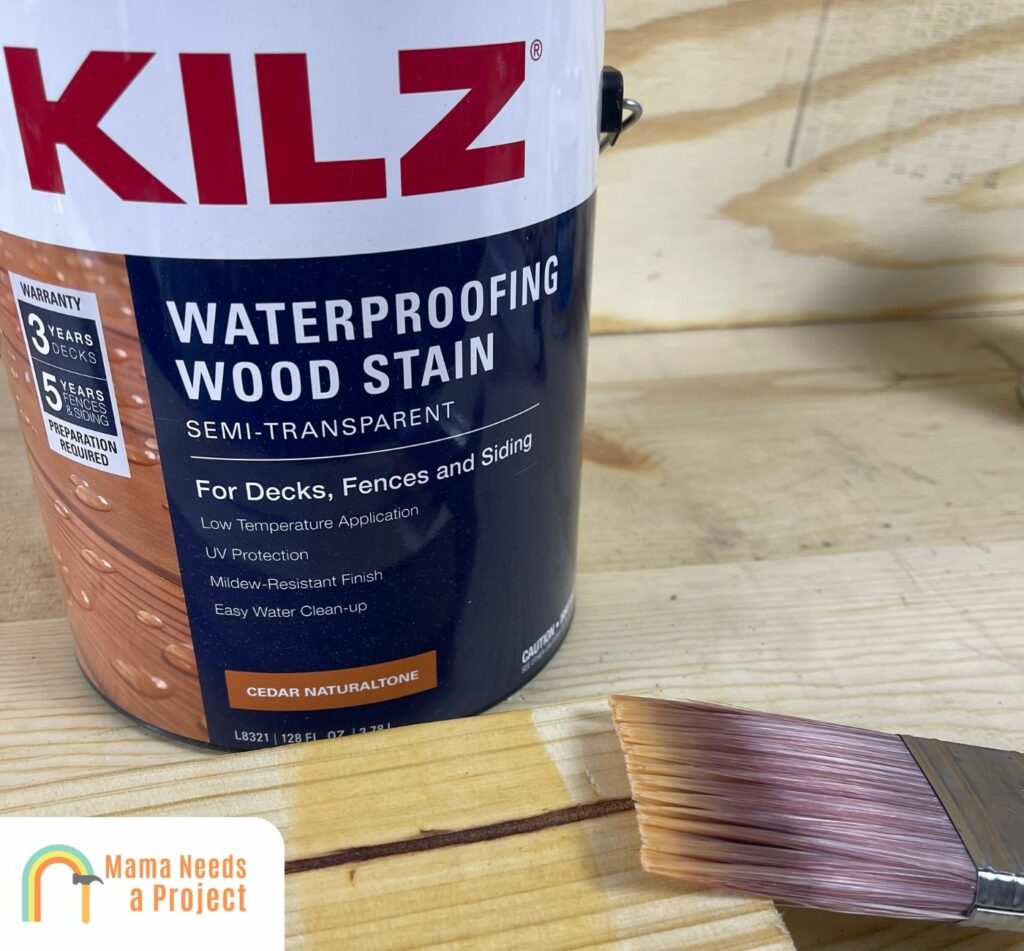
As the name indicates, water-based stains contain a water base rather than an oil one, making them less volatile and more eco-friendly. Water-based stains also have the advantage of drying faster and achieving a darker tone than other types of stains.
You have the option of adding pine oil or another type of oil to water-based stains for extra color and flair. However, this will negate many of the advantages that water-based stains have over other types of stains. Additionally, if you want to stain some of the more difficult and stain-resistant woods, like maple, pine, and birch, water-based stains are the preferred option.
Overall, water based stains are great for wood projects that don’t require extreme protection. I’ve used it on tons of my smaller projects over the years and it’s super easy to apply, which I love.
Oil Based Stain
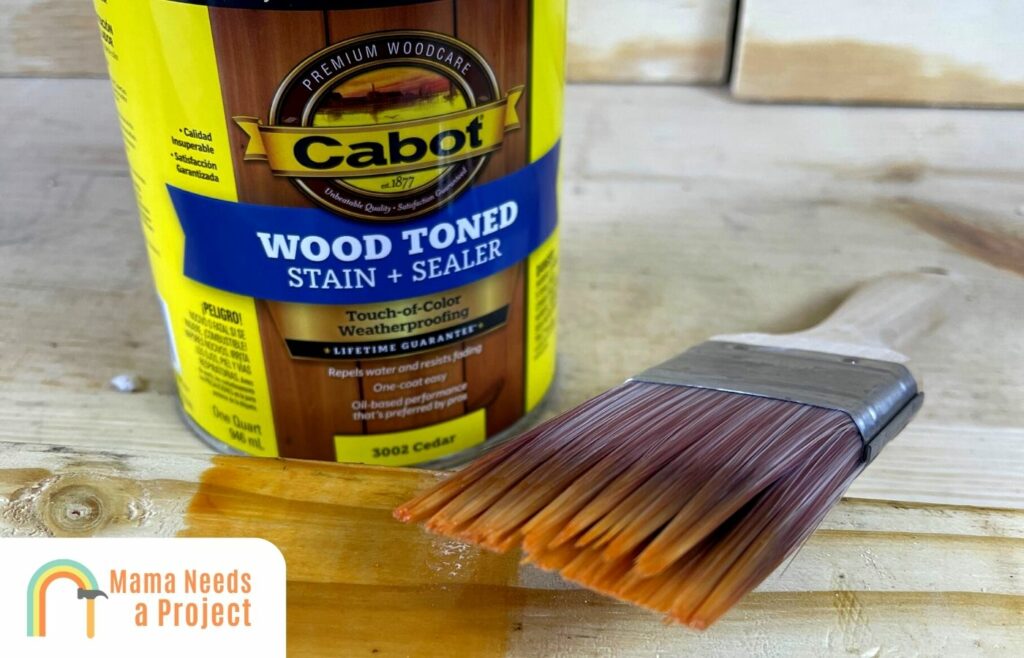
On a more traditional note, you can also opt for oil-based stains.
Oil-based stains are the OG when it comes to wood stains, and they used to be the only option. While they remain very popular, many people like the eco-friendly and user-friendliness of water-based stains.
The advantage of using oil-based stains is that they are very durable and don’t require much long-term maintenance. They also hold up better to the elements, making them the a great stain for outdoor furniture.
The primary downside of oil-based stains, apart from being more volatile and less eco-friendly, is that they tend to develop a yellowish hue over time, which could take away from your wood’s natural color.
The best wood stains are often oil based because of their durability and protection offered.
Metalized Dye Stain
If you want to use one of the lesser-known options, you can also opt for a metalized dye stain. Metalized dye stain refers to several different types of stain, including metallic, acid, raising, non-grain, and more. It is not, however, a special type of oil or water-based stain and belongs to a category of its own.
You can use metalized dye stains on various indoor and outdoor applications but with certain caveats. For starters, metalized dye is not food-safe, so don’t use it in the kitchen or for your dining room table. It also doesn’t hold up as well to the elements, so be wary of using it in exposed outdoor situations.
On the upside, however, metalized dye stains are easy to apply, quick to dry, and help wood retain its natural grain and beauty.
Water Soluble Stain
Another unique and modern type of stain is water-soluble dye stains. Water-soluble dye stains are loved for how deeply and vigorously they can penetrate through a wood’s surface, giving it a deep and lasting color.
This type of stain is best used for refined and classic woods, such as mahogany and cherry, but they go great with any type of stain-friendly wood.
Gel Stain
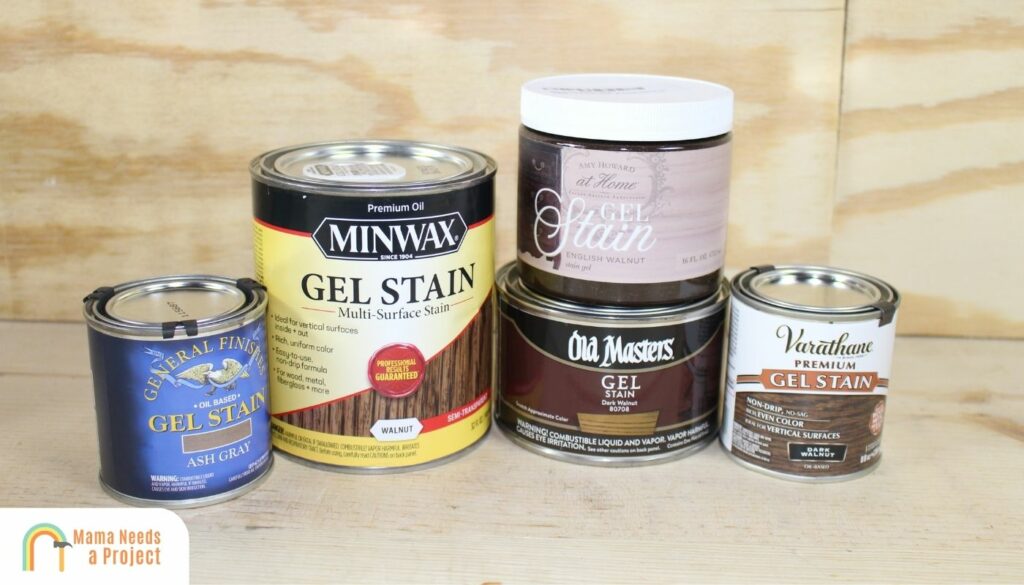
Similar to how water-soluble stains work, gel stains are deep penetrating stains that provide a clean, sleek, and lasting finish.
Gel stains are more similar to oil-based stains than water-based ones but are unique to themselves. You can use gel stain with any type of wood, no matter how hard or soft it is, and it will provide the same uniform outcome.
Varnish Wood Stain
Finally, you have the option of using a wood varnish stain rather than a traditional type of stain. Rather than penetrating deeply into the pores of wood, the varnish is more of a surface stain. Once applied, it will look more like wood has an extra layer or bump rather than that it has a deep finish.
However, even though varnish wood stain works differently than traditional stain, it will provide an equally beautiful and protective finish. The difference is that it’s protecting and beautifying it from the outside rather than the inside.
How to Stain Wood Resistant to Stains
As I said before, while you can technically stain any type of wood, some woods are more resistant to staining than others. Here’s a quick look at how to take that stubborn wood and make it accept the stain of your choosing.
Wipe-On Oil Finish
Your first option is to apply a coat or two of wipe-on oil finish.
This finish acts as a sealer and helps prepare the wood surface to receive the stain that is to come readily. Wipe-on oil will also help saturate the grain of the wood and seal off some of the larger pores so that it takes on a clean, even coat of finish.
Pre-Stain Conditioner
Alternatively, you can opt for a pre-stain wood conditioner, which does the same thing as a wipe-on oil finish, but on a more advanced level. In addition to saturating the wood’s grains and pores, pre-stain conditioners can also help with surface texture problems that could lead to an uneven or splotchy coat.
Regardless of whether you prefer a wipe-on oil finish or a pre-stain conditioner, it’s important first to sand and clean the wood to prepare it for application. Failing to stain the wood before you pre-coat and coat it will result in an uneven, blotchy stain, regardless of the type of wood or stain you’re using.
It’s also a good idea to practice on scrap pieces of wood before staining something that actually matters to you. There’s a chance that the stain or pre-conditioner doesn’t look the way you intended, and you’ll need to change tactics.
Here’s a great video showing exactly how to stain wood!
Best Stain Tones For Different Types of Wood
Now that you have a better idea of the types of stains to use and the woods to which you can apply them, let’s look at how the tone and color of the wood affect the type of stain you should use.
Warm Tones
There are more woods with warm tones than any other type of tone, but they aren’t all necessarily stain-friendly. For instance, pine and birch have fairly warm tones, but they aren’t known for their ability to absorb stains. Red oak, mahogany, and hickory, on the other hand, are very stain-friendly and have especially warm tones.
Therefore, the best stain to use with these types of woods is a medium brown stain that doesn’t darken it more than it already is but that also doesn’t give it too much of a light tone. Using a light stain on warm wood could lead to discoloration.
Neutral Tones
If you’re using wood with a neutral tone, such as white oak or walnut, it’s best to use a light wood stain. Light wood stains will help your natural wood retain its natural beauty, for which white oak and walnut are famous.
You can optionally try to use a dark stain with neutral tones, but it defeats the purpose of using beautiful woods like oak and walnut.
Cool Tones
Ash is the most stain-friendly wood with a cool tone, although this category also includes maple and poplar. Regardless of which type of wood you use, however, it’s important to use dark or semi-dark stains so that you retain the wood’s natural beauty.
As with neutral and warm tones, using a stain color that’s the polar opposite of the wood’s natural color will take away from its beauty, texture, and depth.
FAQs
Does staining wood change its color?
Depending on the type of wood and stain you’re using, the stain could potentially change the wood’s color. For instance, if you use a dark stain with a wood species of a neutral or light color, you’re likely to darken the wood substantially. Therefore, if you want to stain wood for protection but not for coloring purposes, it’s best to use a stain as similar in color to the wood as possible.
Is there a difference between a wood stain and a wood dye?
Wood stains are great for both protection and aesthetics, whereas wood dye typically only offers aesthetics and does not protect wood.
Do I need to add sealer after staining wood?
Although it is not a requirement, adding a coat of sealer on top of your stain will add an extra layer of protection. The stain will offer some protection, but not as much as sealer and stain.
Final Thoughts
As you can see, there are many different types of wood that are great for staining, but oak, ash, cedar, chestnut, and hickory are the best.
However, while these woods are the best for staining, you can apply stain to any type of wood as long as you properly prepare it beforehand.


